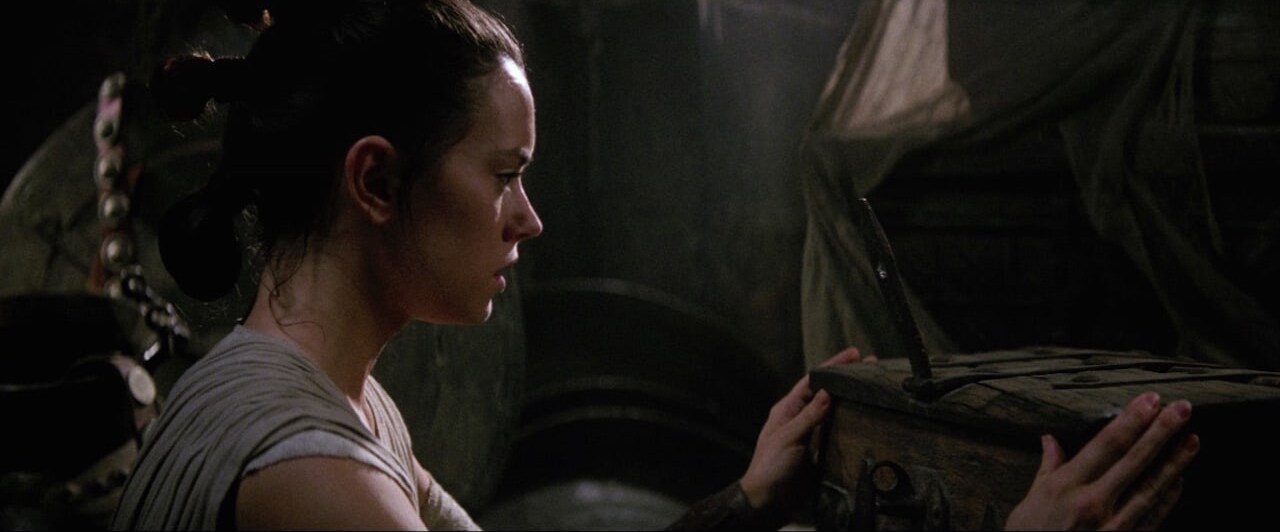One of the great things about Star Wars is that it inspires endless debates and opinions on a wide array of topics. Best bounty hunter? Most powerful Jedi? Does Salacious Crumb have the best haircut in the saga? In that spirit, StarWars.com presents From a Certain Point of View: a series of point-counterpoints on some of the biggest — and most fun — Star Wars issues. In this installment, two StarWars.com writers take a stand on the most powerful moment in the sequel trilogy -- Star Wars: The Force Awakens, Star Wars: The Last Jedi, and Star Wars: The Rise of Skywalker -- now streaming on Disney+.
Rey’s confrontation with Palpatine on Exegol is the most powerful moment in the latest trilogy, says Emily.
The arc Rey goes through from the beginning to the end of the sequel trilogy is perfectly captured in her confrontation with Palpatine. As Palpatine strikes lightning at his estranged granddaughter, Rey uses Leia’s lightsaber to withhold the overwhelming power coming from him. Palpatine claims, “I am all the Sith.” And Rey, while using the Force to pull Luke’s saber to her free hand, confirms, “And I… I’m all the Jedi.” With both lightsabers, the lightning deflects right back at Palpatine until he’s nothing more than dust.
To understand just how powerful this moment is, we have to go back to where Rey started. When we first met this humble scavenger in Star Wars: The Force Awakens, Rey specifically told Maz, “I don’t want any part of this,” while refusing to take Luke’s lightsaber that called to her on Takodana. At that point, Rey made her priorities clear; she just wanted to get back to Jakku to wait for her family to return. Of course, things didn’t go to plan and when she was faced with fighting Kylo Ren on Starkiller Base, she summoned the lightsaber to her hand using the Force, her first step in accepting her place with the Resistance, although she still had many questions and much to learn.
That led Rey to her next destination: Ahch-To. After helping the Resistance recover the map to Luke Skywalker in the hopes that he’d be able to help them, Rey traveled to the Unknown Regions to retrieve the fabled Jedi master in Star Wars: The Last Jedi. When she arrived, Rey was insistent that she was there because Leia sent her and that the Resistance needed his help. It wasn’t until Luke questioned her that she opened up. “I need someone to show me my place in all this,” she told him. Despite Kylo Ren’s attempt to convince her that she has “no place in this story,” and that she’s, “no one” -- but not to him, I know – she ultimately succeeded in discovering who she was.
Which brings us back to The Rise of Skywalker and the final battle. Rey stands her ground against the most evil being in the galaxy, uses the lightsaber she once refused, and confirms her place in the story. Rey is all the Jedi. And with that, her arc is complete.
It’s Luke Skywalker’s final duel with Kylo Ren, says Dan.
As the modern mythology, Star Wars is well known for evoking the pathos within so many of us, which is one of the reasons we continually come back for more. And while there are many powerful moments to choose from in the sequel trilogy, there can only be one winner, and naturally, it’s from the hero that started it all: Luke Skywalker.
At the end of The Force Awakens, we learn that Luke is hiding out on the mysterious planet Ahch-To, in a self-imposed exile, to essentially contemplate his existence and reinvent himself. His perceived failure with his nephew, Ben Solo, has left him bereft of hope, which is something altogether unexpected. How can one of the greatest heroes have given up on himself and the galaxy?
The short answer: He’s human. Even though Luke is arguably one of the most powerful Jedi in history, he is still a mere mortal. Yes, Luke has accomplished so much and saved so many. His Jedi skills are staggering and he did help redeem his father to the light side of the Force. He’s not perfect, but that just makes him more relatable. If the best of us can have doubts and make mistakes, it gives the rest of us hope that it’s OK to mess up or feel lost. The farm boy from Tatooine seems to have temporarily forgotten that.
But, that’s not the end of Luke’s story. It’s just one chapter in an epic volume that culminates with perhaps the ultimate sacrifice: Luke’s triumphant return on Crait. With John Williams’ sweeping, “The Spark,” building to a crescendo, Luke Skywalker reunites with his sister, Leia, winks at C-3PO, and goes to face down the First Order all by himself. Unphased by the firepower of a line-up of AT-M6 walkers, with one casual flick to remove any dust from his shoulder, Luke Skywalker lets it be known that he is back to light the spark of hope for the Resistance and the galaxy.
From the beginning, Luke Skywalker has been a beacon of hope for generations of Star Wars fans. When we learn that Luke Force-projected himself across the galaxy, knowing full well he would die from the incredible strain, it amplifies who this character is and what he means to so many. It is his ultimate sacrifice that shows us what love and hope truly are, and while we are not able to take on Kylo Ren and the First Order or send an astral form of ourselves across the galaxy, we can learn from our mistakes, believe in ourselves, and stand up for what is right, in spite of overwhelming odds. That is why Luke’s confrontation with the First Order on Crait is the most powerful moment in the sequel trilogy.



















